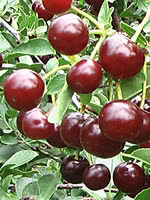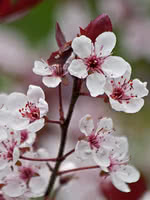Mon-Fri 9am - 5pm Mountain time
Carmine Jewel Cherry vs Purple Leaf Sand Cherry
Prunus x kerrasis Carmine Jewel
Prunus x cistena
CUSTOM GROW
Carmine Jewel Cherry is a cold-hardy dwarf sour cherry. It is typically highly productive and one of the first varieties to ripen in summer. It produces deep red, tart fruit that are well-suited for fresh eating, baking, and preserves. In the spring, beautiful white flowers cover the branches, adding ornamental value.
Carmine Jewel Cherry was developed at the University of Saskatchewan. It is recommended to grow dwarf sour cherries as a shrub rather than a small tree. The shrub form tends to bear fruit earlier and is less susceptible to winterkill.
Sour cherries are self-fertile; however, planting with additional varieties for cross-pollination can increase yields.
Purple Leaf Sand Cherry provides bright reddish-purple leaves that turn bronze-green in the fall. In the spring, tiny flowers with a pinkish white hue bloom. The flowers are small, but the impact comes from the shrub blossoming all at once.
The Purple leaf sand cherry can be susceptible to pests and diseases in more humid areas; a typical life span is approximately 15 years. Not suitable for a privacy hedge on its own but is often alternated with lilacs. Often used as an accent plant that attracts birds and bees.
Carmine Jewel Cherry Quick Facts
Purple Leaf Sand Cherry Quick Facts
Toxicity: the leaves and seed are slightly toxic

